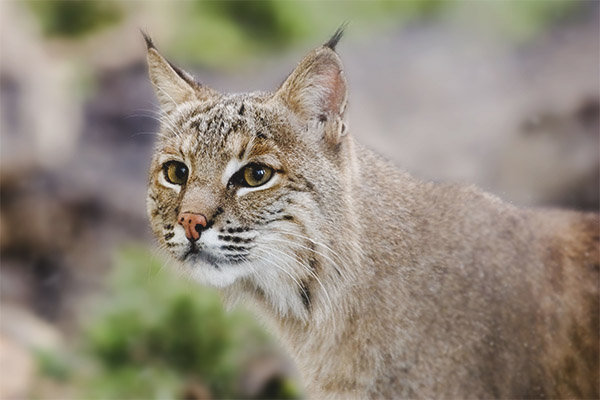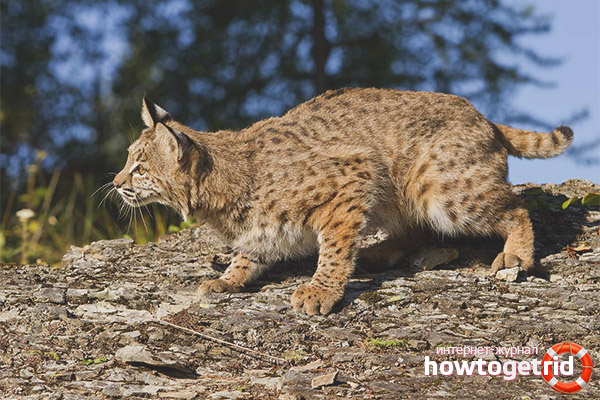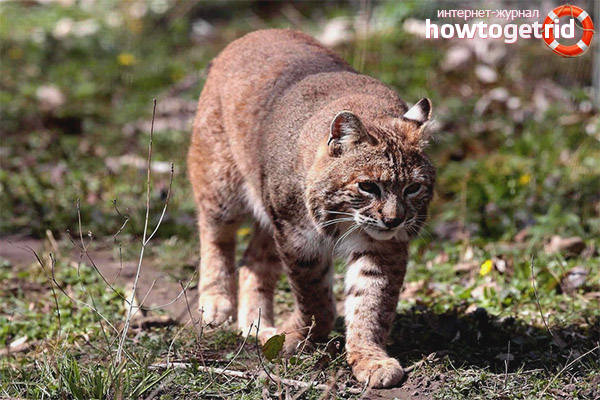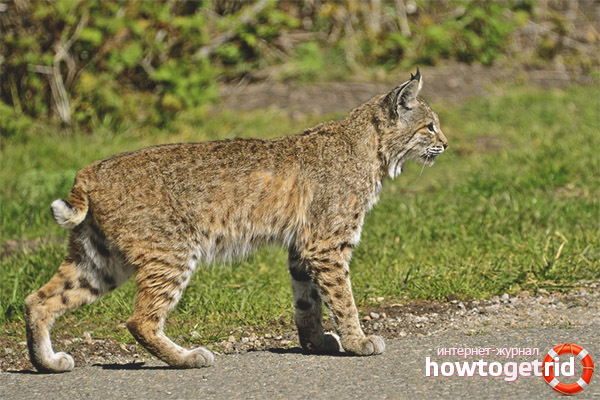The content of the article
The red or red lynx is a predatory animal in North America. To some, it may be known as “bobcat”. Despite its modest size, the red-haired lynx is the largest predatory cat in its habitat. For many years now, it has been a mystery to zoologists. Seeing and tracking her is not easy, although the lynx is not afraid of humans. That is why any grain of information obtained about it is valuable.
general description
Bobket is a relative of the usual trot, but it is half the size. Body length rarely reaches 90 cm, and weight ranges from 6 to 16 kg. Among individuals of this species most often there are representatives with a weight equal to about 10 kg.
Its fur has a brown-red color with a large amount of pigment (because of this, the red lynx is sometimes called red).There are dark spots all over the fur that help the beast to disguise against the background of foliage and tall grass. In Florida, there are individuals with an exceptionally black color. Also known cases of albinism among lynx. The tail is rather short relative to the body and is 15 cm. On it is a white mark, by which the bobket can be distinguished from other related species.
The body of the rye lynx is very strong and lean. The prey that has fallen into these developed paws has no chance to get back, and the structure of the limbs allows the bobket to make jumps 5 m long, overtaking the pursued goal in two accounts.
Spread
The habitat of this animal is entirely located on the American continent, which is a rather unusual phenomenon. Red-haired lynx settles in the United States, in the South and West of Canada, near southern Mexico. Despite the rather extensive settlement, these cats are under threat of extinction due to uncontrolled extermination from humans.
Lifestyle
Bobkat's preferences in the choice of housing are quite diverse. The beast can settle in both arid areas, and in marshy lowlands or forest. Some individuals settle near human habitation and spend their whole lives among the cultural landscape (conditions created by man). Despite the fact that these animals have perfectly mastered climbing trees, they do not use them for permanent habitation, preferring to move up in case of danger or heat. They also rarely swim, preferring to do so only in summer in order to cool.
Although the red lynx dominates in size, it is not the main predator of the continent and has natural enemies.These include the Canadian lynx, cougar and jaguar, a meeting that can end up with death for the bobcat.
The basis of the diet of red lynx is food of animal origin. She gladly hunts rabbits, mice, porcupines and gophers. Sometimes bobcat has enough strength to overcome white-tailed deer or livestock, but such cases are extremely rare. For prey, the red-haired lynx advances with the onset of twilight. However, in the northern latitudes there is less opportunity for her to get high-calorie food, so the bobcat uses any time of the day to hunt if there is a potential food nearby.
After eating the animal prefers to rest. If something is left of the meal, she carefully hides the traces of the recent feast. Like some other species of big cats, the red-haired lynx is capable of hiding food on tree branches.
For the trot, an important task is to protect the territory, for which the males scratch trees and make marks with urine. One animal can occupy an area of 100 square kilometers, and this is far from the limit. Females occupy about 50 square meters. km and defend their possessions as fiercely as the males. Several males can divide the border area and provide their habitat for 3 females.Animals use the smell of urine to demonstrate their readiness for mating.
Breeding
The breeding season begins with the first warm days of spring. Females of lynx trotter bear the fruit for 53 days, after which a litter of several blind kittens is born. Toddlers see their sight at 7-9 day, after which another 2 months they eat mother's milk. The milk of the female bobcat is very fat and thick, it contains a high concentration of nutrients. Ginger lynxes treat their kittens with care, constantly licking them. The female is always ready to take care of the offspring and in case of danger will transfer the small predators to a new refuge.
Throughout the time, the male feeds all the females living on its territory. He will give them a portion of the spoil, even if he himself is starving. This is a rather unique phenomenon that is rarely found among other representatives of the animal world. For some time, the female does not allow the male to the burrow, preferring to take food in neutral territory. But when the kittens grow up a little and get stronger, the male is allowed to bring food directly to the shelter and leave the meat to the young for feeding.
Raising young lynx is an important element of the life of the female.When the young reach the age of several months, she leaves the hole with them and starts walking them on her own territory, teaching them the basics of hunting and protection from natural enemies. At about half a year, the kittens are already entering their first prey, which is under the strict control of the mother. It develops their endurance, providing physical exertion. During the entire period of growing up, kittens play with each other, which is also an important component of their physical development.
Hunting
The red-haired lynx does not hunt in a flock, preferring to do this thing alone. An interesting feature of the bobcat and other lynxes is that they can ambush and wait in the shelter of an unsuspecting victim. A lynx always kills prey in the same way: it first cuts through the carotid artery and then breaks the neck. The spontaneity of the attack allows her to hunt animals that are much larger than hers.
Threat of extinction
The skin of a lynx trot is a valuable trophy for which several thousand dollars are given on the black market.And the secrecy of a lynx and its fearlessness in front of a person only adds to the poachers of excitement. Another reason why this species is being hunted is the damage from the red-haired lynx caused to the farms. They attack birds and small animals, which is why farmers, at the first opportunity, try to eliminate the animal that has started to visit their lands.
At the moment, the red lynx is listed in the Red Book as a species that faces complete extermination. Attempts are being made to restore the bobcat population and to propagate the individuals present in zoos, but so far these actions have not brought any particular result.
Interesting and unusual facts
- The lynx develops the same speed in water as a human, and also can dive for a while.
- At an early age, the red-haired lynx responds well to training and taming, so the kitten has every chance of becoming a full-fledged pet, which is kept outside the cage.
- The average life expectancy of a bobcat in nature is 18 years, in captivity - 30 years.
- The individuals of rye lynx living in northern latitudes (for example, in Canada) are noticeably larger than their southern counterparts.
- In the first year of growing up, kittens add an average of 25 grams of weight per day.
- While jumping and walking, the red-haired lynx places its hind legs exactly on the spot where its forelimbs were located a second ago. Despite the opportunity to develop high speeds of movement, the lynx will not be able to pursue prey for a long time. If you can not grab the victim in the first 30 seconds, then it is likely to leave her alone.
Video: Red Lynx (Lynx rufus)














To send